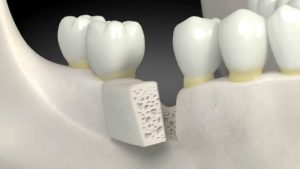Bone Grafting
Bone Grafting
When it comes to dental implants, it’s all about the bone. Think of the implant as a screw being
placed in wood. In this case, your bone is the wood and the implant is the screw. We would like
to have a thick block of strong wood so we may place a large diameter screw. This allows for
the screw to withstand stronger forces and last longer. This is similar when it comes to jaw bone
and dental implants.
When you lose a tooth, the bone in that area will change over time. This change results in the
bone becoming thinner and weaker. This often results in poor quality and quantity of bone
suitable for the placement of dental implants.

To prevent the bone from changing this way, bone graft is placed immediately after a tooth is
removed. This is called “socket preservation” and is the most common type of bone graft. In the
past, we used to place your own bone in these areas. This was done by harvest bone from
other parts of your jaw. However advances in using donated bone have allowed us to avoid
having to harvest your own bone.
gives us the best results when trying to preserve the shape of the jaw bone for a dental implant.
There are other benefits to bone grafting as well besides having a great site for a dental implant.
When you remove a tooth and place bone graft, the area is coveted with a protective
membrane. This prevents food from trapping inside the healing area, which can be
uncomfortable or even prevent proper healing. Also there is usually less pain after surgery due
to the healing properties of the bone graft.


